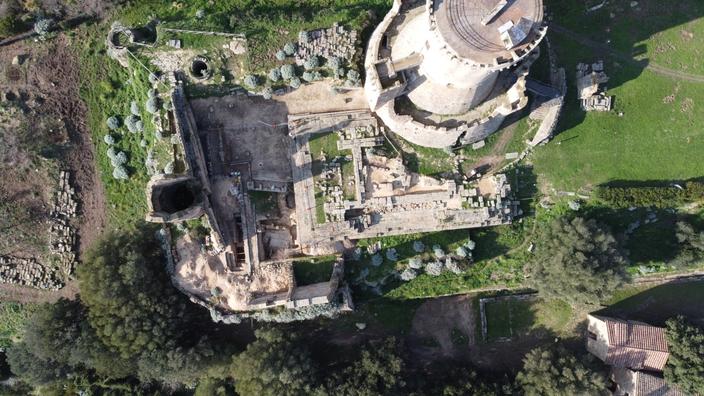The defeat had something of a Marseille Trafalgar.
Between 541 and 535 BC.
BC, somewhere in the Tyrrhenian waters, between Corsica, Sardinia and the Italian coast, two ancient fleets faced each other.
A row of Marseille sails and oars on one side, the double of Etruscan and Carthaginian spurs on the other.
The clash of these two forces, known as the Battle of Alalia, marked the end of the brief Greek implantation in Corsica.
Nearly 2500 years later, some memories of the nautical confrontation have resurfaced on the coast of Campania, in the oldest ruins of ancient Velia (province of Salerno).
Memories in arms, emerging from the terrestrial thigh of Italian soil.
Read alsoTwenty years of Inrap: "Archeology gives voice to the mute of history"
A fragment of a decorated shield and two bronze helmets from the 6th century have been unearthed from the deepest layers of the acropolis of Velia, the Archaeological Park of Paestum and Velia announced on Monday.
These extremely rare objects for this time were kept in a former votive deposit, alongside an assortment of various weapons, some of which are made of iron, welcomed the Italian team in charge of the excavation operation.
“This discovery sheds new light on a fascinating page of ancient history,”
said Massimo Osanna, director of Italian museums and acting director of Velia Park, in a statement.
Weapons from the naval battle of Alalia between Phocaeans and Carthaginians unearthed in Italy
Go to slideshow (5)
Very different from the Corinthian helms traditionally associated with ancient Greece, the two helmets of Etruscan origin evoke at first sight forms closer to the morion of the conquistadors than to the ancient Mediterranean.
Their types of headgear, called Chalcidian for one, and “de Negau” for the other, are nevertheless fairly typical of Etruscan defensive armament.
“These are remains offered to Athena, in all likelihood remnants of the Battle of Alalia,”
said Massimo Osanna, who hopes to uncover some telltale inscriptions while cleaning the objects.
Regional feud
How did Italian archaeologists make the connection between an ancient weapons deposit discovered at Velia (also known by its Greek name of Elea) and a particular naval battle? First, there is the history of the city, of Marseille origin. About fifty years after the foundation of Marseilles, the inhabitants of Phocaea fled the advance of the Persians in the Greek world and left to found a trading post in Alalia (now Aleria, in Upper Corsica), on the eastern coast of the island. The location is located at a crossroads between Marseille, northern Etruscan Italy as well as Magna Graecia - the Italian boot colonized by Greek city-states. The strategic site immediately attracted the greed of the Carthaginians, the North African regional power, then already established in Sardinia.Defeated in the open sea, off Alalia, the Phocaeans crossed the Tyrrhenian Sea and then founded Elea, in the north of Magna Graecia.
Read alsoDisbelief in Greece after the filming of a sex scene on the Acropolis
However, this primitive Elea, founded around 540-535, is at the heart of the excavation campaign carried out since July 2021 by the teams of the Archaeological Park.
Just completed, the site has brought to light the remains of an archaic temple under the main sanctuary, now preserved, of the acropolis of Velia.
18 meters long - for a width of seven meters - the building was built of brick and covered with plaster, with polygonal foundations.
In addition to its form, its religious vocation could be determined thanks to ceramic remains bearing inscriptions of a sacred nature.
"The oldest structures in this temple date from 540-530 BC, in the years immediately following the battle of Alalia
," says Massimo Osanna.
The presence of Etruscan weapons in a votive deposit dated from the founding of the city thus makes it possible to seriously consider the hypothesis of a trophy from the battle of Alalia.
“It is possible that the Phocaeans fleeing Alalia erected the temple immediately after their arrival, as tradition dictated
,” summarizes the Italian chief archaeologist.
The exiles bought the land from the locals in order to settle down and quickly resume the flourishing trade that had made their reputation.
And to ensure the benevolence of the divinity, they added to their offerings weapons snatched from their enemies during this memorable naval battle.
“A quarrel of Alalia which sounded the hallali of the claims OM in Corsica.

